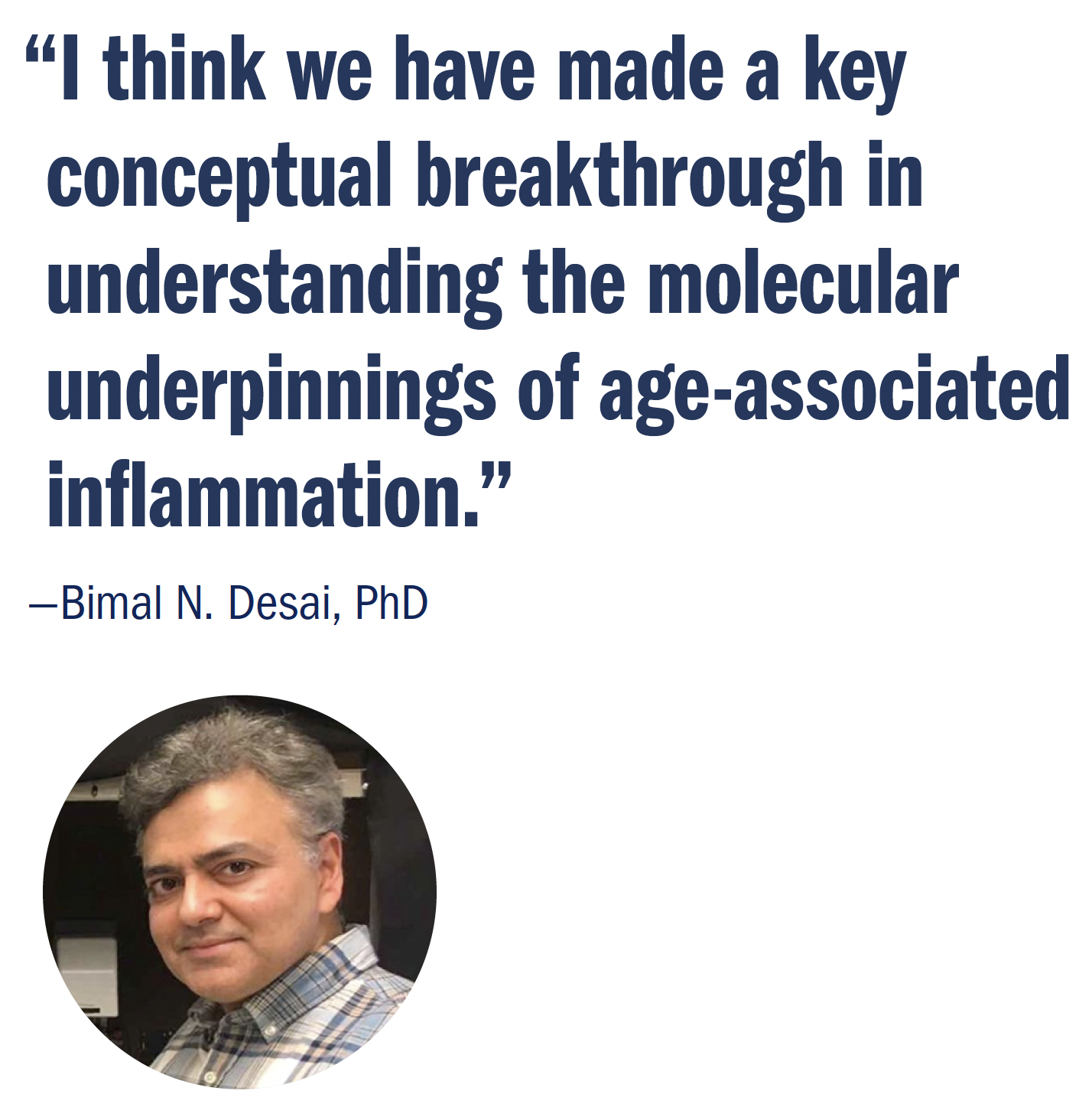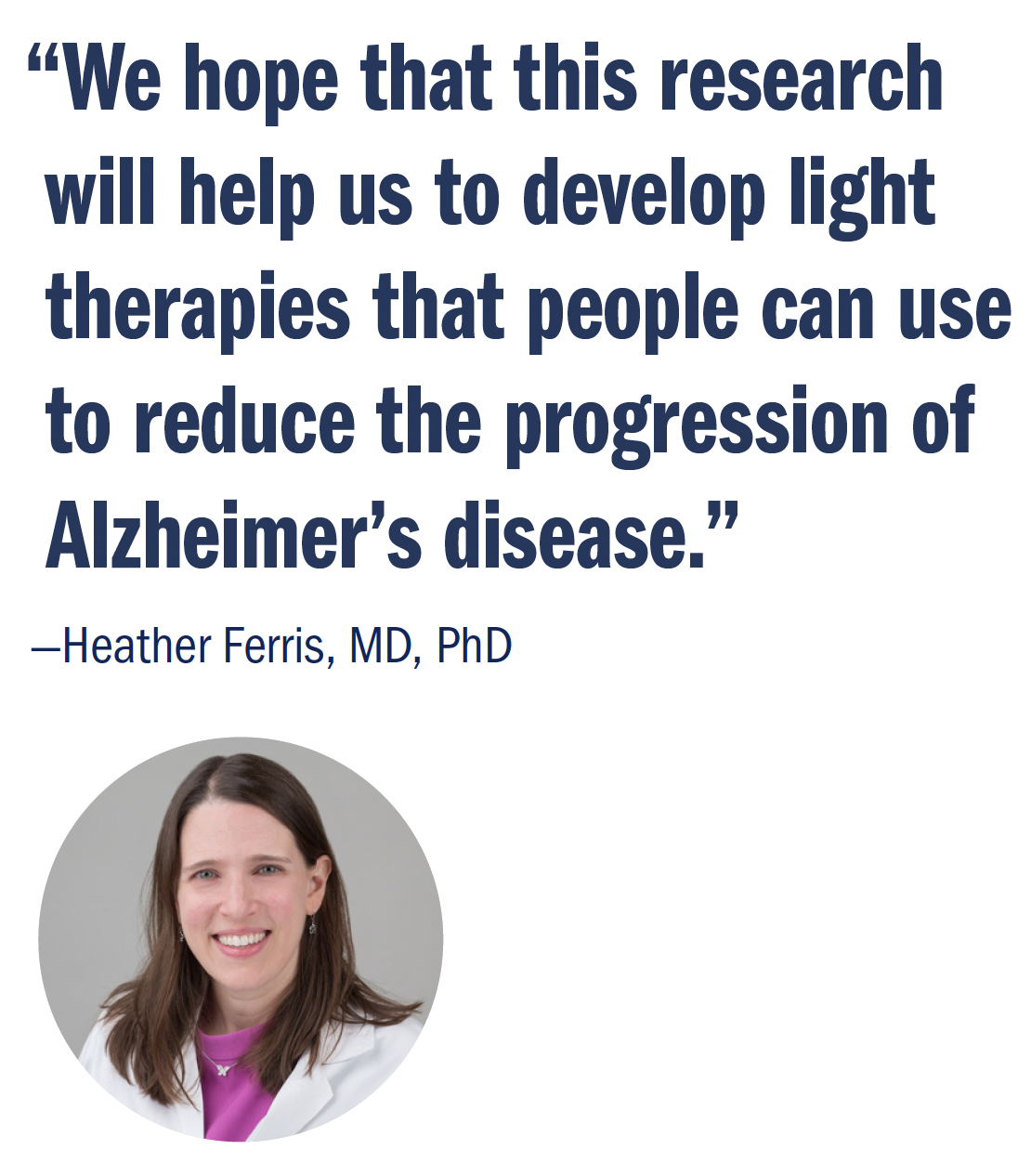'Sundowning’ and ‘Inflammaging'
UVA discoveries increase understanding of Alzheimer’s and age-related diseases.
Research teams from two departments at UVA School of Medicine have uncovered new clues about the biological causes and consequences of aging and Alzheimer’s symptoms. Together, these discoveries are raising new hope for effective treatments and eventually cures for age-related conditions that devastate millions of Americans daily, including heart disease and dementia. Private support of experimental research is crucial for making scientific breakthroughs like this at UVA Health. The following two studies were made possible by the generous support of The Owens Family Foundation.
Inflammation Discovery Could Slow Aging, Prevent Age-Related Diseases
School of Medicine researchers have discovered a key driver of chronic inflammation that accelerates aging. That finding could let us slow the clock to live longer, healthier lives, and may allow us to prevent age-related conditions such as deadly heart disease and devastating brain disorders that rob us of our faculties.
So what drives this harmful inflammation? The answer is improper calcium signaling in the mitochondria of certain immune cells. Mitochondria are the power generators in all cells, and they rely heavily on calcium signaling.
The UVA Health researchers, led by Bimal N. Desai, PhD, found that the mitochondria in the immune cells called macrophages lose their ability to take up and use calcium with age. This, the researchers show, leads to chronic inflammation responsible for many of the ailments that afflict our later years.

The researchers believe that increasing calcium uptake by the mitochondrial macrophages could prevent the harmful inflammation and its terrible effects. Because macrophages reside in all organs of our bodies, including the brain, targeting such “tissue-resident macrophages” with appropriate drugs may allow us to slow age-associated neurodegenerative diseases.
“I think we have made a key conceptual breakthrough in understanding the molecular underpinnings of age-associated inflammation,” said Desai, of UVA’s Department of Pharmacology and UVA’s Carter Immunology Center. “This discovery illuminates new therapeutic strategies to interdict the inflammatory cascades that lie at the heart of many cardiometabolic and neurodegenerative diseases.”
THE INFLAMMATION OF AGING—‘INFLAMMAGING’
Macrophages are white blood cells that play critical roles in our immune systems and, in turn, our good health. They swallow up dead or dying cells, allowing our bodies to remove cellular debris, and patrol for pathogens and other foreign invaders. In this latter role, they act as important sentries for our immune systems, calling for help from other immune cells as needed.
Scientists have known that macrophages become less effective with age, but it has been unclear why. Desai’s new discovery suggests answers.
Desai and his team say their research has identified a “keystone” mechanism responsible for age-related changes in the macrophages. These changes, the scientists believe, make the macrophages prone to chronic, low-grade inflammation at the best of times. And when the immune cells are confronted by an invader or tissue damage, they can become hyperactive. This drives what is known as “inflammaging”—chronic inflammation that drives aging.
Further, the UVA Health scientists suspect that the mechanism they have discovered will hold true not just for macrophages but for many other related immune cells generated in the bone marrow. That means we may be able to stimulate the proper functioning of those cells as well, potentially giving our immune systems a big boost in old age, when we become more susceptible to disease.
NEXT STEPS
Fixing “inflammaging” won’t be as simple as taking a calcium supplement. The problem is not a shortage of calcium so much as the macrophages’ inability to use it properly. But Desai’s new discovery has pinpointed the precise molecular machinery involved in this process, so we should be able to discover ways to stimulate this machinery in aging cells.
“This highly interdisciplinary research effort, at the interface of computational biology, immunology, cell biology, and biophysics, wouldn’t have been possible without the determination of Phil Seegren, the graduate student who spearheaded this ambitious project,” Desai said. “Now, moving forward, we need an equally ambitious effort to figure out the wiring that controls this mitochondrial process in different types of macrophages and then manipulate that wiring in creative ways for biomedical impact.”

Enhanced Light Sensitivity May Play Key Role in Alzheimer’s
New Alzheimer's research from UVA Health suggests that enhanced light sensitivity may contribute to “sundowning”—the worsening of symptoms late in the day—and spur sleep disruptions thought to contribute to the disease’s progression.
The new insights into the disruptions of the biological clock seen in Alzheimer’s could have important potential both for the development of treatments and for symptom management, the researchers say. For example, caregivers often struggle with the erratic sleep patterns caused by Alzheimer’s patients’ altered “circadian rhythms,” as the body’s natural daily cycle is known. Light therapy, the new research suggests, might be an effective tool to help manage that.
Further, better understanding Alzheimer’s effects on the biological clock could have implications for preventing the disease. Poor sleep quality in adulthood is a risk factor for Alzheimer’s, as our brains, at rest, naturally cleanse themselves of amyloid beta proteins that are thought to form harmful tangles in Alzheimer’s.
“Circadian disruptions have been recognized in Alzheimer's disease for a long time, but we've never had a very good understanding of what causes them,” said researcher Thaddeus Weigel, a graduate student working with Heather Ferris (Med ’06), MD, PhD, of the University of Virginia School of Medicine’s Division of Endocrinology and Metabolism. “This research points to changes in light sensitivity as a new, interesting possible explanation for some of those circadian symptoms.”
UNDERSTANDING ALZHEIMER’S DISEASE
Alzheimer’s is the most common form of dementia, affecting 50 million people around the world. Its hallmark is progressive memory loss, to the point that patients can forget their own loved ones, but there can be many other symptoms, such as restlessness, aggression, poor judgment, and endless searching. These symptoms often worsen in the evening and at night.
Ferris and her collaborators used a mouse model of Alzheimer’s to better understand what happens to the biological clock in Alzheimer’s disease. They essentially gave the mice “jet lag” by altering their exposure to light, then examined how it affected their behavior. The Alzheimer’s mice reacted very differently than did regular mice.
The Alzheimer’s mice, the scientists found, adapted to a six-hour time change significantly more quickly than the control mice. This, the scientists suspect, is the result of a heightened sensitivity to changes in light. While our biological clocks normally take cues from light, this adjustment happens gradually—thus, jet lag when we travel great distances. Our bodies need time to adapt. But for the Alzheimer’s mice, this change happened abnormally fast.

The researchers initially thought this might be because of inflammation in the brain—“neuroinflammation.” So they looked at immune cells called microglia that have become promising targets in our efforts to develop better Alzheimer’s treatments. But the scientists ultimately ruled out this hypothesis, determining that microglia did not make a difference in how quickly mice adapted. (That’s not to say that targeting microglia won’t be beneficial for other reasons.)
Notably, the UVA scientists also ruled out another potential culprit: “mutant tau,” an abnormal protein that forms tangles in the Alzheimer’s brain. The presence of these tangles also did not make a difference in how the mice adapted.
The researchers’ results ultimately suggest there is an important role for the retina in the enhanced light sensitivity in Alzheimer’s, and that gives researchers a promising avenue to pursue as they work to develop new ways to treat, manage and prevent the disease.
“These data suggest that controlling the kind of light and the timing of the light could be key to reducing circadian disruptions in Alzheimer’s disease,” Ferris said. “We hope that this research will help us to develop light therapies that people can use to reduce the progression of Alzheimer’s disease.”
These articles originally appeared in UVA Today.
Learn how you can support UVA Health’s groundbreaking research on Alzheimer’s and related diseases by contacting Jas Heim, Executive Director of Development, Healthcare Philanthropy, at jheim@virginia.edu or call us at 434.924.8432 or 800.297.0102.

